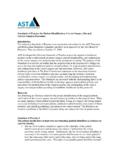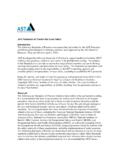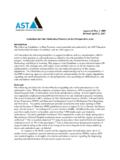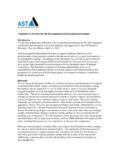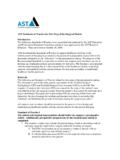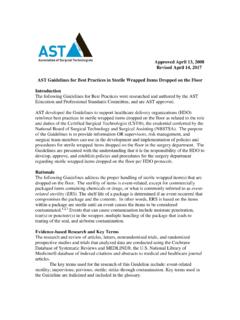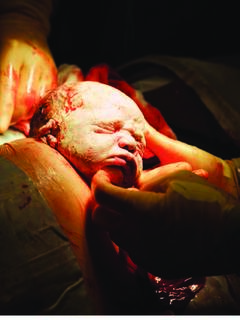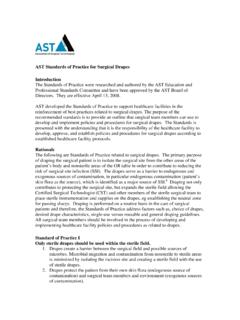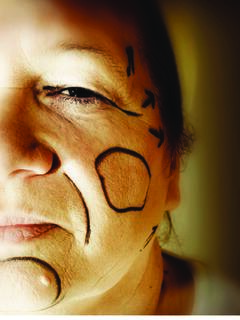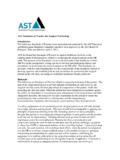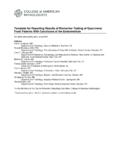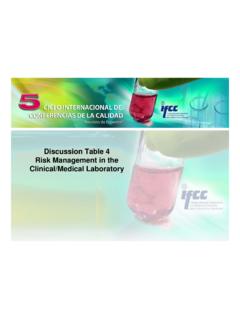Transcription of Standard Handling Care Surgical Specimens
1 AST standards of Practice for Handling and care of Surgical Specimens Introduction The following standards of Practice were researched and authored by the AST Education and Professional standards Committee and have been approved by the AST Board of Directors. They are effective April 13, 2008. AST developed the standards of Practice to support the healthcare facilities in the reinforcement of best practices, related to the Handling and care of Surgical Specimens in the perioperative setting. The purpose of the standards is to provide an outline that healthcare workers (HCWs) in the perioperative setting can use to develop and implement policies and procedures for the Handling and care of Surgical Specimens .
2 The standards are presented with the understanding that it is the responsibility of the healthcare facility to develop, approve, and establish policies and procedures for the Handling and care of Surgical Specimens according to established healthcare facility protocols. Rationale The following are standards of Practice related to the proper Handling and care of Surgical Specimens in the perioperative setting. The Handling of Specimens before they reach the pathology department is referred to as the preanalytic It is a process that involves many HCWs and many steps including communication of information among the Surgical team members, labeling, packaging, and transport of the specimen that may contribute to increasing the risk of error.
3 In one six-month study conducted at a university healthcare facility, the following was identified 5: Of 10,354 surgery department Specimens , 38 had errors. Of the 21,351 total number of Specimens studied that originated from various hospital departments, 54 of 91 mislabeled Specimens originated from the surgery department. Out of those 54, the Surgical procedures in which Specimens were most commonly mislabeled are: breast skin colon prostate Another major concern in addition to mislabeling errors is loss of specimen .
4 When addressing loss of specimen , there are two categories: (1) procedure that can be repeated in order to obtain another specimen ; (2) specimen that cannot be replaced, such as an excised organ or The first category is not optimal since the patient has to repeat the risk of undergoing a procedure again as well as increasing patient morbidity, loss of time from job and family, and increase the patient s mental stress and anxiety. The second category represents the greatest concern since an incomplete diagnosis, misdiagnosis, or delayed treatment, could result in wrong treatment, causing the patient to undergo additional treatment as a safety measure even though it may not be needed, or cause treatment of wrong area of the body.
5 Additionally, for both categories, the healthcare facility is facing possible As previously mentioned, delivering a specimen to the pathology department involves many steps including: 1. Correctly identify the patient. 2. Correctly identify and confirm the specimen by the Surgical team. 3. Placing the specimen in an appropriate container and preservative. 4. Correctly label the specimen . 5. Complete the pathology requisition slip. 6. Transport the specimen to the pathology department. Each of these steps can involve additional sub-steps that increase the risk for error.
6 Therefore, on an overall basis, the purpose of proper Handling and care of Specimens is that the collection, labeling, preservation, transportation and chain of custody ensures continuity of quality care for the patient and provides a method to retrieve needed information. Each HCW involved in the chain of custody must understand and know the procedures for the Handling and care of Specimens , and the consequences to the patient if there are errors. Standard of Practice I The proper Handling and care of Specimens begins during the preoperative phase of patient care and preparations including all communications should involve the Surgical team.
7 1. The Surgical team should coordinate the information concerning the specimen (s) to include: A. Type of specimen , eg frozen section, aerobic or anaerobic, specimen to be placed in preservative B. Confirm with surgeon other types of diagnostic studies to be performed, including Gram stain, acid fast and mycological. C. Anticipated number of Specimens . D. Type and size of needed container(s) including whether they the containers should be sterile or clean E. Will preservative be required and what type of preservative?
8 2. The Surgical team should be aware of any cultural preferences of the patient concerning the specimen , eg certain religions require an amputated body part to be given to the patient. This information should be documented in the patient s chart. A. If the patient requests to keep a specimen , the specimen should still undergo pathological examination, and the Surgical team should follow healthcare facility policies and procedures, including Standard precautions in returning the specimen to the patient. 3. Planning involves communicating with the department(s) and persons that will be involved in the chain of custody including: A.
9 Providing assistance to the pathology department in identifying the Surgical procedures that will have Surgical specimen (s) B. Communicating to the pathology department the Surgical procedures where a frozen section will be required C. Communicating to HCWs involved in the chain of custody any special circumstances, eg specimen for frozen section needing immediate delivery to the pathology department, anaerobic or aerobic culture that needs to be immediately delivered to laboratory. Standard II Specimens to be transported to the pathology department should be placed in the proper container to preserve and protect the specimen .
10 1. Containers should be rigid, impermeable, unbreakable and non-reactive to fixative solutions to prevent HCWs from becoming infected as a result of exposure to infectious 2. The correct size of container must be used to hold and protect Specimens . 3. Containers should have a secure, tight-fitting cover/lid to prevent the fixative solution from escaping in order to prevent the HCW from contamination when Handling the container and to prevent the escape of noxious fumes that could also be a health hazard. 8,18 4.
